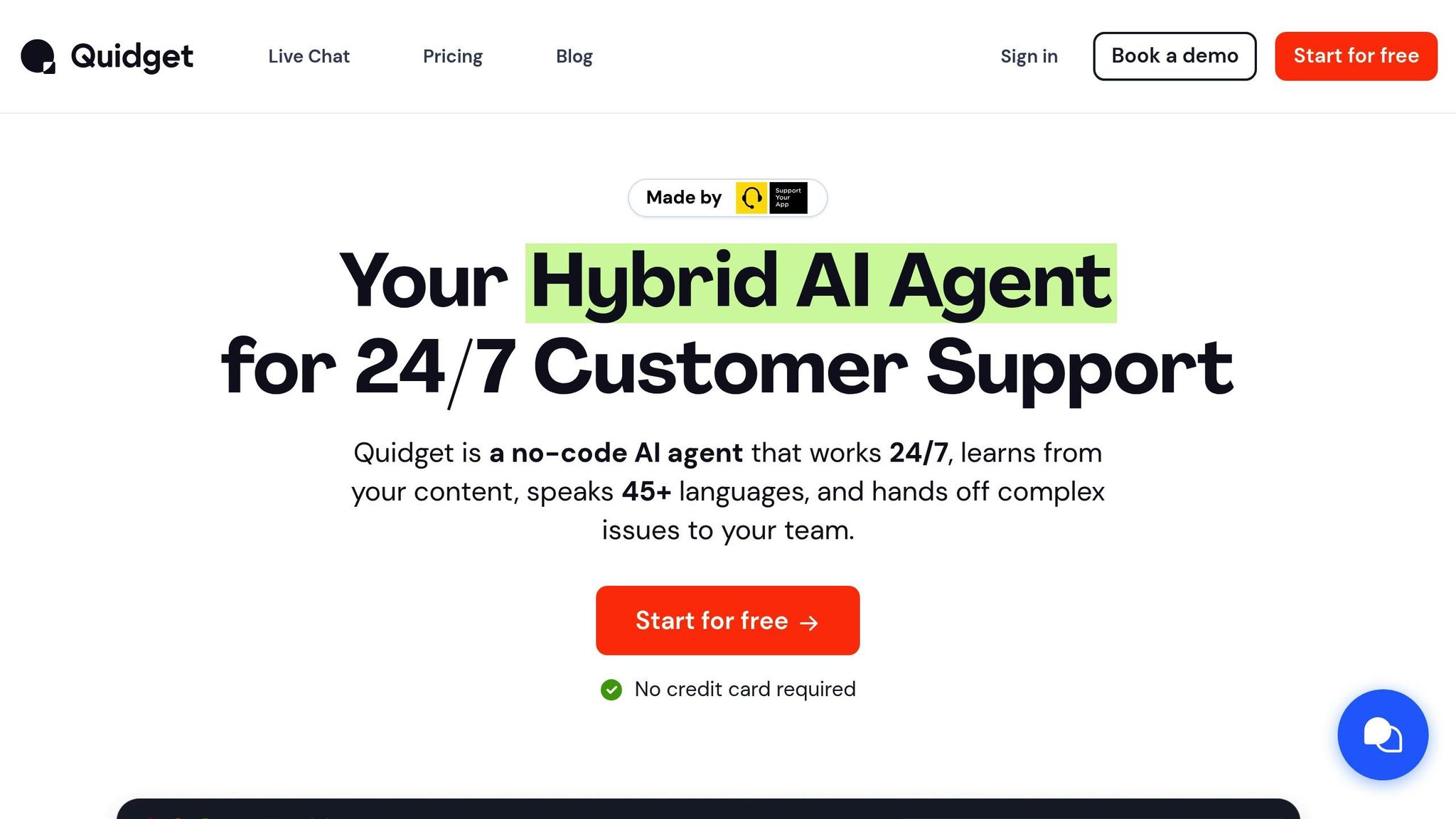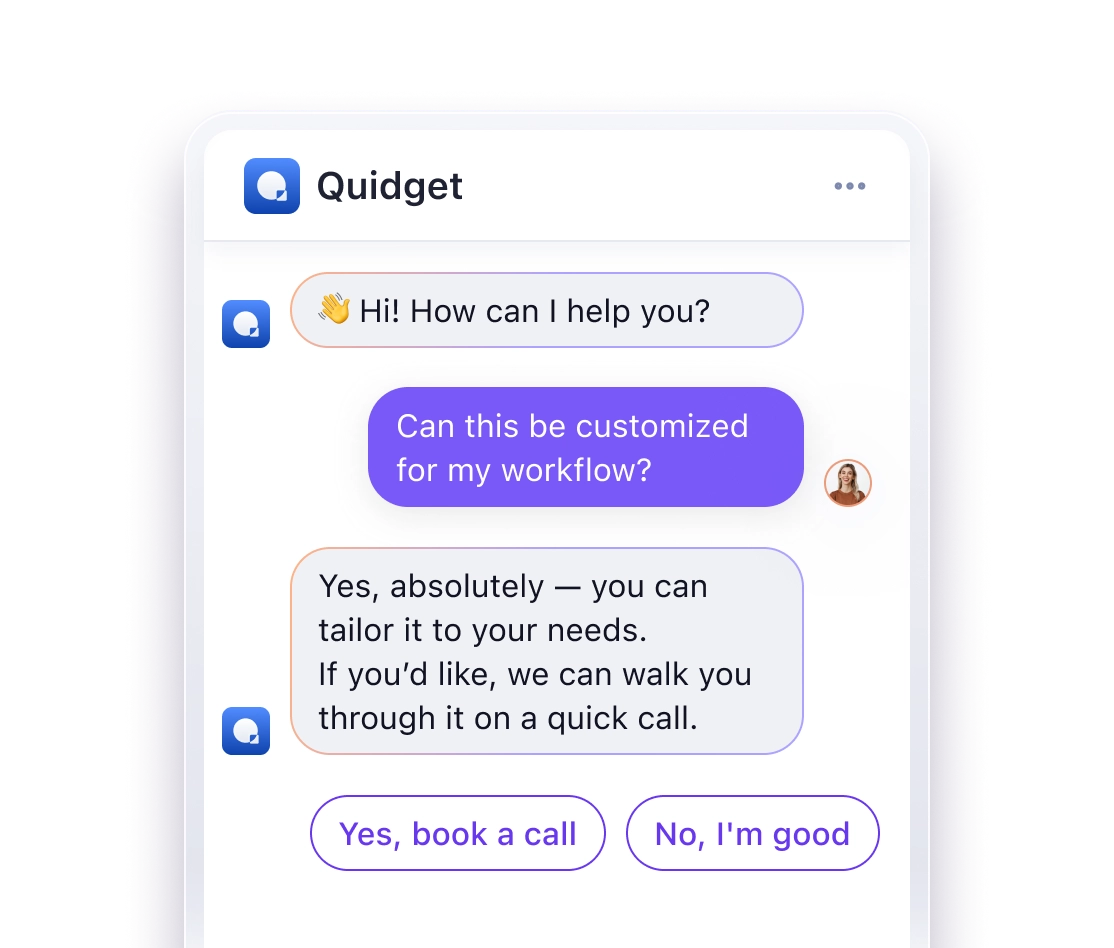AI chatbots are transforming how universities support students by automating over 80% of inquiries and providing 24/7 assistance. Here’s how they help:
- Handle Common Questions: Admissions, financial aid, course registration, campus tours, and tech support.
- Save Time and Costs: Reduce administrative workload by up to 30%.
- Boost Outcomes: Examples like Georgia State’s "Pounce" show improved graduation rates and reduced summer melt.
- Support Remote Learners: Provide instant help for international and distance students.
Key Takeaways:
- Popular Chatbot Tools: Platforms like Quidget, Zendesk, and IBM Watson offer tailored solutions for universities.
- Success Stories: Schools like Georgia State and Thompson Rivers University have seen measurable improvements in student engagement and retention.
AI chatbots are a simple, scalable way to improve student services, cut costs, and enhance academic outcomes.
Key Functions of University AI Chatbots
Managing Student Questions
AI chatbots are perfect for tackling repetitive student inquiries that often overwhelm help desks. For instance, Bryant University’s chatbot, Ask Tupper, handles around 50,000 common questions from 1,000 new students annually, covering 50 popular topics. It provides quick answers on things like class registration, campus building locations, dining hall hours, Wi-Fi setup, housing details, and visitor parking. For example, it informs students that breakfast at Salmanson ends at 10:30 AM and explains why personal wireless printers aren’t allowed in dorms, while offering alternative solutions.
Automating Office Tasks
Chatbots also streamline administrative tasks, saving time and resources. Research shows that a well-trained chatbot can manage over 80% of incoming communications without human intervention. Thompson Rivers University is a great example. Lachlan Todd, their Communications & Systems Coordinator, shared:
"I don’t have a computer science or programming background so finding a chatbot that was simple to build and code-free was crucial – and Comm100 Chatbot delivered on this. With a little learning and guidance from Comm100’s bot architect team, I built our bot from scratch with no technical knowledge. I think anyone who has a social media account can build a Comm100 Chatbot."
These bots can handle tasks like processing document requests, scheduling appointments, updating course details, tracking applications, coordinating campus tours, and managing enrollment.
24/7 Student Support
Students expect instant answers, and AI chatbots provide just that – 24/7 support. They handle questions at any time, assist international students in different time zones, and even offer multilingual options for global users. Whether it’s about enrollment, course registration, financial aid, or campus resources, these chatbots ensure students get immediate help, regardless of office hours. This constant availability makes them an essential tool for universities looking to enhance student services.
Building Your University Chatbot: 3 Steps
Step 1: Identify Key Student Tasks
Start by pinpointing the most common and repetitive tasks that take up staff time.
Georgia State University’s chatbot is a great example. It handles important enrollment-related tasks, such as:
- Answering tuition deadline questions
- Providing guidance on submitting ACT scores
- Explaining FAFSA requirements
The results speak for themselves: this chatbot managed nearly 200,000 student messages, with less than 1% needing staff involvement.
Step 2: Select a Chatbot Platform
Once you’ve identified the tasks, choose a platform that fits those needs. Look for features like:
| Feature | Description |
|---|---|
| Code-free setup | Easy for non-technical staff to use |
| Integration options | Syncs with university systems |
| Multi-language support | Helps international students |
| Analytics dashboard | Tracks how the chatbot is being used |
| Security compliance | Keeps student data safe |
Thompson Rivers University highlights the importance of simplicity. Their Communications Coordinator shared their experience:
"I don’t have a computer science or programming background so finding a chatbot that was simple to build and code-free was crucial – and Comm100 Chatbot delivered on this. With a little learning and guidance from Comm100’s bot architect team, I built our bot from scratch with no technical knowledge. I think anyone who has a social media account can build a Comm100 Chatbot."
Step 3: Add University Content
Now that you’ve chosen your platform, fill it with accurate and useful information. Staffordshire University’s "Beacon" chatbot is a great example of this in action. It includes:
- Answers to 400 frequently asked questions
- Personal timetable details
- Tutor contact information
- Directories for campus resources
Accuracy is key here. For instance, the College Guidance Network’s AVA system ensures precision by using expert-verified content and local academic roadmaps. By focusing on clear and reliable answers, your chatbot can become an essential tool for students.
Top AI Chatbot Platforms for Universities
Platform Features Comparison
Universities need chatbot platforms that seamlessly integrate with their systems and effectively manage student queries. Here’s a side-by-side look at some top options:
| Platform | Key Features | Starting Price | Best For |
|---|---|---|---|
| Element Bolt | – Built for higher education – Personalized student support – Data integration |
$14,000/year | Large universities needing tailored tools |
| Mongoose Harmony | – Real-time chat – CRM compatibility – Tracks student journeys |
$2,500/month | Mid-size schools focused on engagement |
| Zendesk Chat | – Multi-channel communication – Knowledge base integration – Team collaboration |
$19/user/month | Universities already using Zendesk |
| Tidio | – Quick setup – Drag-and-drop flow builder – Basic analytics |
$29/month | Small colleges starting with AI tools |
Another option to consider is IBM Watson Assistant, known for its advanced natural language processing. It’s ideal for institutions needing more sophisticated NLP capabilities.
Quidget Features for Universities

For a more customized approach, Quidget offers several features designed for educational institutions:
- Supports over 45 languages
- Integrates with tools like Zendesk and Calendly
- No-code setup for easy use by admin staff
- Analytics to monitor student engagement trends
Quidget offers two pricing plans:
- $16/month: Includes core features
- $79/month (Pro): Adds content import via web crawler, custom branding, student system integration, and multi-channel deployment (e.g., WhatsApp, Slack).
With proper setup, Quidget can handle over 80% of incoming student questions, significantly reducing administrative workload.
sbb-itb-58cc2bf
University Chatbot Success Stories
Admissions Office Automation
Back in 2018, California State University, Northridge (CSUN) launched CSUNny, a chatbot designed to assist incoming freshmen. To measure its impact, the university divided its freshman class into two groups. The results? After three years, students who used CSUNny had a graduation rate of 5.6%, compared to 3.6% for those in the control group. This highlights how chatbots can do more than just help with admissions – they can also enhance student engagement.
"Students recognize that it’s a bot, but they interact with the bot very differently and often very vulnerably because it’s not a human…They feel they can articulate and share stories that they wouldn’t necessarily do with a person. It’s been a great way to engage underrepresented students in a way that feels safe."
Georgia State University introduced Pounce, another chatbot, with a focus on early engagement. Pounce reduced summer melt by 22%, leading to 324 additional enrollments. It also managed over 200,000 messages, with 63% of students interacting with it more than once.
Chatbots like these are now being used beyond admissions, bringing similar advantages to distance learning.
Distance Learning Support
AI chatbots are also making a difference in supporting remote learners. At the University of Murcia in Spain, Lola, their chatbot, answered over 38,708 questions from 4,609 students with more than 91% accuracy.
Thompson Rivers University (TRU) took it a step further by automating 83% of after-hours chats for distance learning support. This shows how AI can extend student services well beyond regular office hours.
"Even if students aren’t using the bot and asking questions, it does seem like, on some level, they are registering that people on campus want to help them…There is a whole host of research suggesting that that feeling of belonging is one of the biggest predictors of retention and graduation."
Optimizing Student Support Services with AI: Lessons from the University of Gloucestershire
Conclusion: Next Steps for University Chatbots
AI chatbots are changing the way universities support students, showing clear gains in graduation rates and engagement levels. Some universities have found that well-designed chatbots can handle over 80% of student inquiries without needing human assistance.
To make the most of these tools, here’s how universities can move forward with implementing chatbots:
- Start with a free trial of an AI platform like Quidget to explore its basic features.
- Integrate your university’s existing resources, such as website content, FAQs, and documentation.
- Monitor chatbot performance and gather user feedback.
- Analyze conversation transcripts to refine responses and ensure accuracy.
Northwestern University serves as a great example of what’s possible. In 2023, their Canvas Chatbot managed to handle 92% of queries without escalation, while user engagement jumped by 45% compared to the previous year. This highlights how chatbots can do much more than just answer simple questions.
Take advantage of Quidget’s free 7-day trial to see how it works for your institution. No credit card is required, and you can set up your first AI chatbot in under 2 minutes. Plus, with support for over 45 languages, it’s ready to assist your entire student community.



